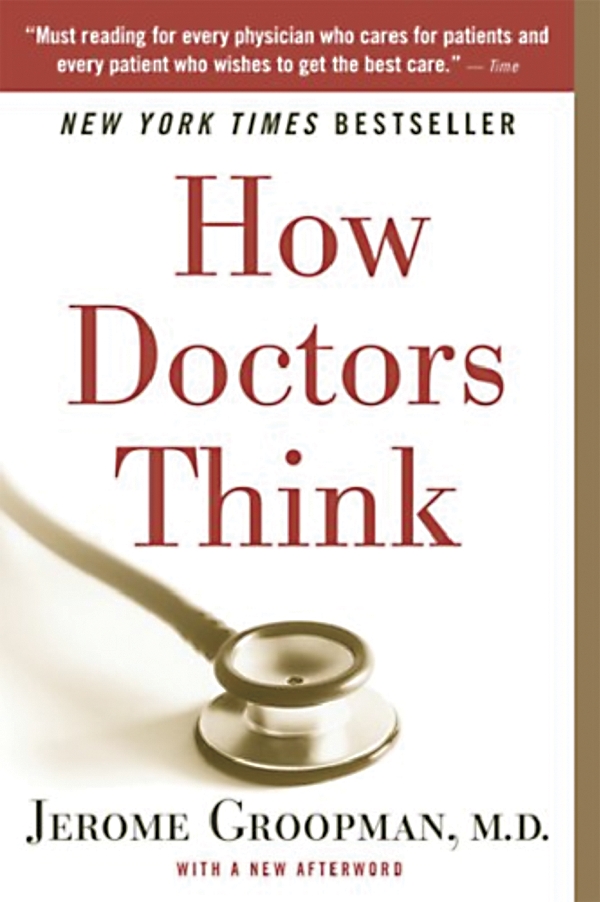OVERALL RATING Very good
STRENGTHS Addresses an important but often overlooked topic
WEAKNESSES Does not quantify the consequences of errors made in clinical decision making
AUDIENCE Medical professionals and the general public
In How Doctors Think, Groopman analyzes how physicians come to make diagnostic and treatment decisions, and how this process can be improved upon. He approaches this in a case-based manner, by way of analyzing mistakes made in diagnosis and treatment.
In each chapter, Groopman presents cases in which particular diagnoses were arrived at in error, often by separate, but not always independently thinking, physicians. He also presents cases in which difficult diagnoses were arrived at correctly, drawing attention to the important differences between the cognitive processes at play in each case and the resultant outcome. By doing this, Groopman highlights several types of common cognitive errors made by physicians. It is worth briefly reviewing them here. In fact, being more aware of these potential cognitive traps might well prevent one from making many of the clinical errors described in this book.
A commission bias is the tendency toward action rather than inaction. When considering whether the patient should be treated or not, this bias leads one toward treatment, as it is—wrongly—believed that one is therefore “doing something” for the patient. Satisfaction of search is the tendency to stop searching for a diagnosis once one has found something of clinical interest, even though this might not be central to the presenting problem. Groopman points out that while finding something might be satisfactory, not finding everything is suboptimal. The availability error is the tendency to apply what one commonly experiences or sees when making a diagnosis of a new patient. This leads the physician to see similar cases in the same way, often while ignoring important differences between them. The anchoring error is the tendency to seize on an initial symptom or finding and allowing this to cloud clinical judgment. Finally, the attribution error is the tendency to fit people into stereotyped roles based on one’s past experiences or what one might have been told by colleagues. This prevents the physician from viewing the patient’s clinical picture de novo.

The author makes an apt point when explaining that even with the myriad technologies available, language is still the foundation of clinical medicine. With respect to the omnipresent diagnosis and treatment algorithms, Groopman describes a case to illustrate how important it is that physicians apply algorithms within the context of the specific patient being treated. The ability to know when algorithms work for patients and when to choose different treatments, which might conflict with algorithms, becomes clearer the more patients one treats. Groopman also illustrates that how we present choices to patients can strongly influence the choices patients make. For example, a statement like “a 30% chance of improvement” might be more positively received by patients than “a 70% chance of failure and death,” even though both statements are clinically equivalent. Moreover, in a situation like this, it is important to define what is meant by improvement, as this might be misinterpreted to mean cure.
My criticism of Groopman’s approach in this book is that although he presents cases in which the kinds of cognitive errors physicians can make are well highlighted, these cases make up a relatively small sample size and do not provide the reader with an accurate estimation of the degree to which such errors occur. Groopman does not present data on the absolute number and type of diagnostic errors reported in the literature to help frame the scope of the problem for the reader. And the problem is not insignificant. That said, this does not nullify the central thesis of the book.
I finished reading How Doctors Think at the end of my second year at medical school, having started it several months earlier but abandoning it for periods of time because of the rigours of the medical curriculum. Most of the 4-year medical programs in Canada are the preclinical or preclerkship years for students. It is the time when we learn much about the pathophysiology of disease, a bit about patient-doctor relationships, little about the process of clinical decision making, and essentially nothing about the cognitive errors and biases that might compromise the accuracy of our decisions—let alone ways of recognizing and correcting said biases. Groopman explains that, in medicine, understanding why we sometimes get things wrong is important—if not essential—to understanding how to get things right. My only regret about this book is not having read it sooner. Even with its shortcomings, this is a book I would recommend to any medical professional, particularly new incoming medical students.


